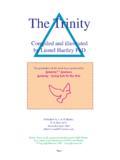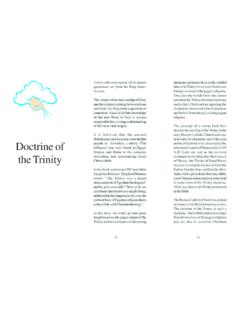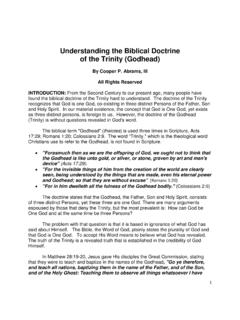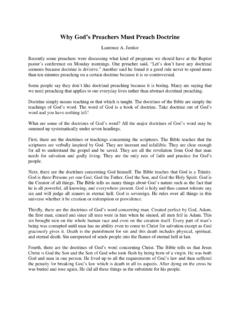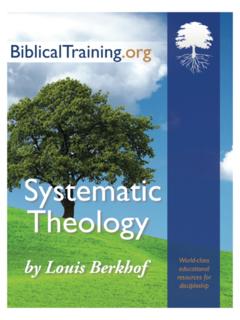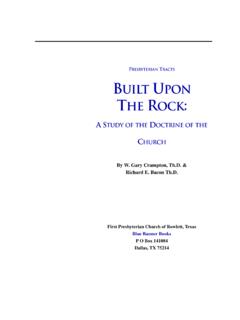Transcription of THE TRINITY, THE HOLY SPIRIT, AND WORSHIP A Paper
1 THE trinity , THE holy spirit , AND WORSHIP_____A PaperPresented toDr. Daniel AkinThe Southern Baptist Theological Seminary_____In Partial Fulfillmentof the Requirements for 27020_____byAndrew P. KulpJanuary 25, 2001 Revised February 13, 20011As the professor suggested, Millard Erickson outlines an excellent method forembarking upon theological study. With minor adjustments in preface to the theological study,this author generally follows the same sequence in formulating an understanding of theparticular theological topic being studied. The primary difference between Erickson s model and this author s process is that thisauthor pulls the awareness of personal presuppositions out into a pre-study analysis of the topicbeing studied. Identification of presuppositions becomes part of the theological question, whichin turn will give a clearer definition to the problem, lending to more specific and directed study.
2 Therefore, this author inserts the following task preceding the Erickson model: Consider thepersonal presuppositions and experiences that have caused the theological question to arise. Develop a detailed theological question in view of these presuppositions and experiences. Considering the personal history related to the doctrine, what differing views are the theologianaware of prior to embarking upon the study which could help direct the study? Prior to study,what are the theologian s personal views of these differing views? Why does he/she hold theseviews? Is the theologian prepared to be corrected in the study of this doctrine?With these presuppositions in place next to a detailed theological question, this authorthen follows the Akin-modified Erickson outline. Where Erickson suggests the development ofa personal theme or motif around which to approach theology, this author generally employs aGod-centered, application-oriented approach.
3 This author views much of his theology asfocusing on God s plan through history, particularly God s acts of glorifying himself throughredeeming man. However, the result of theological study is not merely understanding, but indiscovering the impact which the understanding will have on the life of the a theological method in place, complete theological study can E. Ward, Layman s Library of Christian Doctrine, vol. 10, The holy spirit (Nashville, TN:Broadman Press, 1987), , the wake of the conservative resurgence within the Southern Baptist Convention, anincreased communication between active evangelical denominations has risen. As missionsorganizations around the world work together to accomplish the task of world evangelization,theological differences become apparent, but are often overlooked in order to focus on thegreater task at hand.
4 While this practice is commendable for the sake of world evangelization,theologians may also take advantage of this increased communication through dialogue relatedto the doctrinal differences. Brothers and sisters in Christ from a different background can ofteninfluence the theologian s own perspective in such a way as to reveal greater truths in the pagesof holy with this author, many Christians who have been reared in strongly conservativetheological circles have been starved for sound teaching on the doctrine of the holy SPIRIT, primarily as a reaction to fear of excess related to the When these Christians come incontact with Pentecostal believers, the doctrine is discovered, and these starved Christians willtend to drift toward these holy spirit focused groups. In response, many conservatives haveaccused the Pentecostal groups of an overemphasis on the holy spirit and experience, sacrificingthe Word of God and the gospel about author has been taught, and admittedly has instructed others that there is noreference in the Bible for worshiping the holy spirit , therefore direct WORSHIP of the holy Spiritshould be avoided.
5 Instead, those with this view suggest that the holy spirit s role is limited todirecting the believer in the WORSHIP of the Father and the Son. This statement may be a reaction33G. W. Bromiley, trinity , in Evangelical Dictionary of Theology, ed. Walter E. Elwell (Grand Rapids, MI:Baker Books, 1984), the excesses of other groups. Through a study of the doctrine of God, the author wasreminded that the holy spirit is indeed a part of the Triune Godhead, and therefore may haveevery right to be worshiped along with the other two persons. Therefore, the theologicalquestion to be answered: what scriptural references, if any, would support a claim that the HolySpirit is ultimately unfit to be worshiped with the other two persons of the Godhead? Subsequently, what is the proper role of the holy spirit within the Godhead, and as a part of thebeliever s WORSHIP of that Godhead?
6 The first place to turn in any discussion of theological topics is the Bible. Consideringthis particular question is directly related to a particular member of the Triune God, theargument to begin with the Bible is strong, as the Bible is God s revelation of himself to man. Therefore, a survey through the Scriptures will be of the greatest help in revealing the nature ofthe holy spirit , and His proper place in the Christian s begin a discussion of the person of the holy spirit , a basic understanding of theTrinity should be established. The Old Testament writers were not directly aware of the tri-unityof God, thus the references to the trinity are minimal. However the concept of the trinity isrevealed through the frequent references to the spirit of God (Gen 1:2), as well as the Angel ofthe Lord (Exod 23:23).
7 The primary contribution of the Old Testament in understanding theTrinity is the unity of God: The Lord our God, the Lord is one (Deut 6:4). The strength of thisargument declares the exclusion of tri-theism, which will be explained New Testament writers were quite clear in emphasizing the Trinitarian nature ofGod, although they never actually used the term. Jesus himself was the primary person44 John D. Davis, The Westminster Dictionary of the Bible, rev. Henry Snyder Gehman (Philadelphia, PA: TheWestminster Press, 1944), Akin, Christian Theology Class Notes, Book 3, Enns, The Moody Handbook of Theology (Chicago, IL: Moody Press, 1989), for the introduction of the doctrine of the trinity . The most glaring picture of theTrinity is found in Jesus baptism as recorded in Matthew 3:16-17. In this narrative, the Son ispresent in bodily form, the holy spirit descends from heaven like a dove and rests on the Son,and the Father speaks from his position in heaven.
8 Furthermore, Jesus claimed that the HolySpirit was not an impersonal force, but rather a distinct person within the Godhead that wouldspeak and guide believers (John 16:13-14).4 Due to the fact that the concept of the trinity is introduced in Scripture, but notexplained, several views of the nature of the trinity are available. There are three primary viewsof the trinity which are not orthodox. Each one fails in one essential element of the trinity . The three essential elements are: (1) there is only one unified God (Deut 6:4; 1 Cor 8:4), (2) allthree persons of the trinity are coexistent and coeternal (John 1:1-5, 14; 14:16; Matt 3:16-17),and (3) all three persons of the trinity are equally God (Rom 1:7; John 20:28; Acts 5:3-4).5 Thethree erroneous views are called Tri-theism, modalism, and denies the unified nature of God, allowing the Father, Son, and holy Spiritto coexist separately from each other.
9 Modalism denies that the three persons of the trinity arecoexistent, but instead suggests they are three manifestations of one God. Arianism denies thedeity of Christ, and therefore denies that the Son is eternal, but rather was created by the , in correct Christian belief, there is one God who is a personal God, who is58 Gregory L. Crosthwait, What Difference Does the trinity Make? (Richardson, TX: Probe Ministries,2000), trinity and Salvation [on-line], accessed 22 January 2001 ; S. Caulley, holy spirit , in Evangelical Dictionary of Theology, ed. Walter E. Elwell (Grand Rapids,MI: Baker Books, 1984), , in three distinct persons known as the Father, the Son (Jesus Christ), and the HolySpirit. Each of the three persons of this Triune God serve a distinct purpose or function withinthe Godhead, but none are subordinate to the others in essence or deity.
10 The three functional distinctions are God the Father as the righteous judge, God theSon as the only One who can satisfy the judgement of the Father, and God the holy spirit as theactive agent who works in the hearts of men and women to convict concerning sin andrighteousness and judgement (John 16:8).8 Therefore, the holy spirit as described in the Bible issubmissive to the Father and Son, but is by no means of lesser value. The analogy of themarriage relationship may be of some value in understanding this. While the wife is of equalvalue to her husband, she is to be submissive to his role as the leader in the family (Eph 5:22).Throughout the formation of the church, the holy spirit is affirmed as a member ofthe Godhead. Theophilus of Antioch was the first recorded author to use the term trinity inreference to the Although the exact nature of the spirit s relationship to the Fatherand Son have been debated, throughout church history the holy spirit has been affirmed as theacting agent within the Triune Again, through a study of the Triune Godhead, a basic understanding of the HolySpirit as God and His function within the Godhead are apparent.
